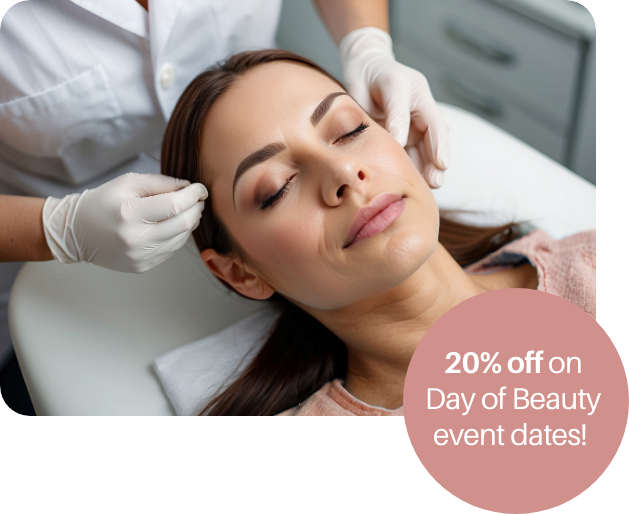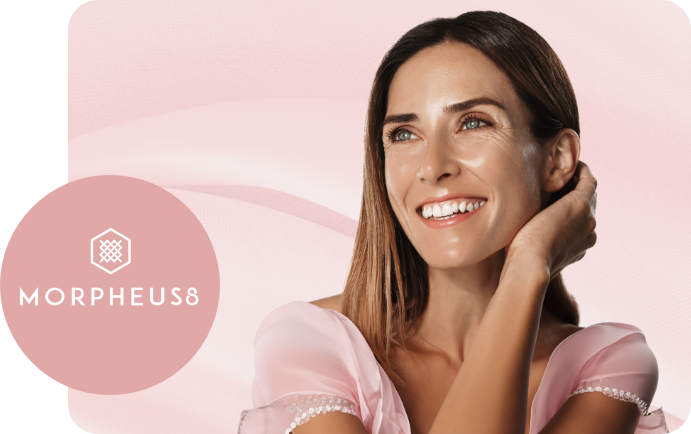Cosmetic Services
Cosmetic
Services
Our team of dedicated dermatological professionals specializes in providing a variety of personalized cosmetic dermatology services to meet your unique needs and help achieve healthier looking skin. We strive to enhance your natural beauty, and provide an exceptional experience.
Don’t miss the next Day of Beauty event!

On Day of Beauty event dates, enjoy 20% off on all cosmetic services! You will also receive a free consultation (a $100 value).
Click here to learn more about our Day of Beauty events dates and services.
Call today to schedule a consultation, or get in touch with us online to hear back from our team about Day of Beauty services.
· North Hollywood: (877) 779-1876
· West Hills: (877) 654-3128
Subject to appointment availability, individual members or patients can receive a free cosmetic consultation (a $100 value).
Unlock better skin with Morpheus8
Discover an advanced skin treatment that combines microneedling with radiofrequency energy for a youthful and glowing appearance. To learn more about our Morpheus8 treatment, click here.
Call today to schedule a consultation, or get in touch with us online to hear back from our team about this exciting new technology!

Meet our experts

Dr. Elena Kandel, M.D.
A renowned, board-certified dermatologist and a member of the American Academy of Dermatology. Dr. Kandel brings her expertise in cutaneous cancers, skin conditions, and advanced cosmetic procedures to provide you with the best care.

Veronika Heteniak, PA-C
A compassionate and skilled physician assistant in dermatology. Veronika’s attention to detail and ability to connect with patients of all ages make her a trusted partner in your skincare journey.

Jessica Wyner, MSN, NP-C
A family nurse practitioner specializing in medical and cosmetic dermatology. Jessica is committed to helping you achieve a better quality of life and improved confidence with tailored treatment plans.
Our Services
We offer a comprehensive range of cosmetic dermatology services, including but not limited to:
• Botox +
1. What is Botox? Botox is a cosmetic treatment known for its ability to reduce the appearance of facial wrinkles. It’s made from a neurotoxin called botulinum toxin, which is produced by the bacterium Clostridium botulinum. Botox works by temporarily paralyzing muscles, leading to a reduction in visible wrinkles.
2. How long does Botox last? The effects of Botox can vary depending on the individual and the area treated. Generally, the results last between 3 to 6 months. Over time, muscle action gradually returns, and the wrinkles reappear, necessitating further treatments to maintain the effect.
3. What are the risks of getting Botox? While Botox is considered safe for most people, some risks are associated with its use. Common side effects can include swelling, bruising, or redness at the injection site. More serious but rare side effects can include issues with muscle weakness, trouble breathing, or speaking. It’s important to discuss potential risks with a qualified healthcare provider.
4. What’s the difference between Botox and Dysport? Botox and Dysport are both types of botulinum toxin injections. While they are similar in their use and effects, there are differences in their formulation, which can affect how quickly they work and how long the results last. Dysport may spread to a broader area after injection, making it suitable for larger areas, while Botox is often preferred for smaller, more targeted areas.
• Chemical peels+
1. What is a Chemical Peel? A chemical peel is a skin treatment that uses a chemical solution to improve the appearance of your skin. This solution is applied to the skin, causing it to exfoliate and eventually peel off. The new skin underneath is often smoother, less wrinkled, and may have fewer blemishes.
2. Who can benefit from a Chemical Peel? Chemical peels can be beneficial for individuals who want to address issues such as fine lines, wrinkles, mild scars, acne, age spots, or uneven skin tone. They are suitable for most skin types; however, a consultation with a skincare professional is recommended to determine if a chemical peel is right for you.
3. Are Chemical Peels painful? Most people experience a tingling or mild stinging sensation during a chemical peel, but it is generally not considered painful. The sensation typically lasts for a few minutes. Your skincare professional will guide you through the process to ensure maximum comfort.
4. How long does it take to recover from a Chemical Peel? Recovery time varies depending on the type of peel. Light peels may require only one to seven days to heal, while medium to deep peels can take several weeks. After the peel, it’s important to follow the care instructions provided by your skincare professional.
5. What should I expect after a Chemical Peel? After a chemical peel, you can expect some redness, similar to a sunburn, and your skin may peel or flake. It’s important to avoid sun exposure and use sunscreen to protect the new skin. Your skincare professional will advise you on the best skincare routine post-treatment.
6. How often should I get a Chemical Peel? The frequency of chemical peels depends on your skin type, the issues being treated, and the type of peel used. Generally, light peels can be done every four to six weeks, while deeper peels may only be necessary once a year.
• Microneedling (Rejuvapen)+
1. What is Microneedling with Rejuvapen? Microneedling, using a device called Rejuvapen, is a cosmetic procedure that involves making tiny punctures in the top layer of the skin using very fine needles. This process is designed to stimulate skin renewal and collagen production, resulting in smoother, firmer, and more toned skin.
2. What skin concerns does Microneedling address? Microneedling is effective in reducing the appearance of fine lines and wrinkles, scars from acne or surgery, stretch marks, and large pores. It can also improve overall skin texture and tone.
3. Is Microneedling painful? Most clients experience minimal discomfort during microneedling. A topical numbing cream is usually applied before the procedure to reduce any sensation of pain. After the treatment, the skin might feel a bit sensitive, similar to a mild sunburn.
4. How long is the recovery time after Microneedling? Recovery time after a microneedling session is relatively short. Most people experience redness and mild swelling for 24 to 48 hours after the treatment. The skin may also feel tight and sensitive to touch during this time.
5. How many Microneedling sessions are required for visible results? The number of sessions needed varies depending on individual skin concerns and desired outcomes. Typically, clients may need 3 to 6 sessions, spaced about 4 to 6 weeks apart. Your skincare professional can provide a personalized treatment plan.
6. What precautions should I take after Microneedling? After microneedling, it’s important to protect the skin from sun exposure and use a broad-spectrum sunscreen. Avoiding makeup, strenuous exercise, and swimming for a couple of days post-treatment is also recommended to ensure proper healing.
7. Can anyone undergo Microneedling? While microneedling is safe for most skin types and tones, it may not be suitable for those with certain skin conditions, like active acne or rosacea, or for pregnant women. A consultation with a skincare professional is essential to determine if microneedling is right for you.
• Morpheus8+
1. What is Morpheus8? Morpheus8 is an advanced skin treatment that combines microneedling with radiofrequency energy. It targets the deeper layers of the skin to remodel and contour the face and body. This technology stimulates collagen production, leading to rejuvenated, firmer, and smoother skin.
2. How does Morpheus8 differ from traditional Microneedling? While traditional microneedling works on the skin’s surface, Morpheus8 goes deeper by delivering radiofrequency energy into the skin’s subdermal layers. This dual action not only enhances skin tightening and rejuvenation but also offers more significant results in contouring and refining the skin’s texture.
3. What skin concerns can Morpheus8 address? Morpheus8 effectively treats a variety of skin issues, including fine lines and wrinkles, acne scars, skin laxity, uneven skin tone, and texture. It’s also used for body contouring and to reduce the appearance of cellulite.
4. Is Morpheus8 treatment painful? Discomfort is typically minimal with Morpheus8 treatments. A topical anesthetic is applied to the treatment area to reduce any pain. After the procedure, patients may experience mild redness and swelling, similar to a sunburn sensation.
5. What is the recovery time after Morpheus8? Recovery time after Morpheus8 is usually short. Most patients can return to their normal activities within a day or two. The treated area may appear red and slightly swollen for up to a week. It is important to follow post-treatment care instructions to ensure proper healing.
6. How many treatments are needed for optimal results? The number of Morpheus8 sessions needed varies based on individual goals and the condition of the skin. Typically, 1-3 treatments, spaced 4-6 weeks apart, are recommended for optimal results. A personalized treatment plan will be provided by your skincare professional.
7. Who is a good candidate for Morpheus8? Morpheus8 is suitable for individuals looking for non-surgical options to rejuvenate and contour their skin. It’s effective for all skin types and tones. However, it’s not recommended for those with certain medical conditions or pregnant women. A consultation with a professional is necessary to determine if Morpheus8 is right for you.
To learn more about our Morpheus8 treatment, click here.
• Lip filler+
1. What is lip filler? Lip filler is a cosmetic procedure that involves injecting hyaluronic acid-based substances into the lips to enhance their volume, shape, and structure. This non-surgical treatment is popular for achieving fuller, more defined lips.
2. How long do lip fillers last? The duration of lip fillers varies depending on the type of filler used and individual factors like metabolism. On average, lip fillers last between 6 to 12 months. Over time, the body naturally absorbs the filler, and the lips return to their original shape, requiring repeat treatments to maintain the effect.
3. Are lip fillers safe? When administered by a qualified and experienced professional, lip fillers are generally safe. The most common side effects include temporary redness, swelling, and bruising at the injection site. It’s important to discuss potential risks and your medical history with your provider.
4. Is the lip filler procedure painful? Pain tolerance varies from person to person, but most people report only mild discomfort during the lip filler procedure. Many lip fillers contain a local anesthetic (like lidocaine) to minimize pain, and additional numbing cream can also be applied.
5. Can lip fillers be reversed? Yes, one of the advantages of hyaluronic acid-based lip fillers is that they can be dissolved using an enzyme called hyaluronidase. This makes the procedure reversible in case of dissatisfaction with the results or in the event of a complication.
6. What should I expect after getting lip fillers? After the treatment, expect some swelling and possibly bruising, which usually subsides within a few days. It’s important to follow aftercare instructions, like avoiding strenuous exercise and extreme temperatures for the first 24-48 hours.
7. Who should avoid lip fillers? Lip fillers are not recommended for individuals with certain allergies, bleeding disorders, active skin infections, or women who are pregnant or breastfeeding. Always consult with a healthcare professional to determine if lip fillers are suitable for you.
• Telangiectasia (removal of broken vessels)+
1. What is Telangiectasia? Telangiectasia refers to small, widened blood vessels visible on the skin, often called broken or spider veins. These can appear anywhere on the body but are commonly seen on the face, nose, cheeks, and legs. Telangiectasia can be red, purple, or blue and are typically harmless but can be a cosmetic concern for many.
2. How is Telangiectasia treated? Treatment options for telangiectasia include laser therapy, intense pulsed light (IPL), sclerotherapy, and electrocautery. These procedures work by targeting and collapsing the blood vessels, causing them to fade over time. The choice of treatment depends on the location and severity of the veins.
3. Is the treatment for Telangiectasia painful? Most patients experience minimal discomfort during treatment for telangiectasia. Laser and IPL treatments might feel like a quick snap or pinch, but are generally well-tolerated. Topical numbing creams can be used to reduce any discomfort.
4. What can I expect after treatment? Post-treatment, you might notice redness, swelling, or bruising in the treated area, which typically resolves within a few days. It’s important to follow your provider’s aftercare instructions, which may include avoiding sun exposure and using sunscreen.
5. How many treatments will I need? The number of treatments required for telangiectasia varies depending on the extent and size of the affected area. Typically, several sessions spaced several weeks apart are needed for optimal results. Your healthcare provider can give you a more precise estimate based on your specific case.
6. Are there any risks or side effects? Common side effects include temporary redness, swelling, and bruising. Rarely, there might be changes in skin pigmentation, scarring, or blistering. It’s essential to have these treatments performed by a qualified professional to minimize risks.
7. How effective is Telangiectasia treatment? Treatments for telangiectasia are generally effective, with many patients seeing significant improvement. However, results can vary, and in some cases, new veins may appear over time, necessitating further treatment.
8. Who is a good candidate for Telangiectasia treatment? Most people with visible broken blood vessels are good candidates. However, those with certain health conditions, pregnant women, or individuals taking specific medications may need to avoid these treatments. A consultation with a healthcare professional is necessary for an assessment.
• Skin tag and SK (seborrheic keratosis) removal+
1. What are skin tags and seborrheic keratoses? Skin tags are small, soft, skin-colored growths that hang off the skin and are commonly found on the neck, armpits, around the groin, or under the breasts. Seborrheic keratosis (SK) is a non-cancerous skin growth that typically appears as a brown, black, or light tan patch on the face, chest, shoulders, or back.
2. How are skin tags and SKs removed? Common methods for removing skin tags and SKs include cryotherapy (freezing), electrosurgery (burning), laser therapy, and surgical excision. The choice of method depends on the size, location, and number of lesions.
3. Is the removal process painful? Most removal procedures are quick with minimal discomfort. Local anesthesia may be used to numb the area, especially for larger tags or SKs. Post-procedure, there may be temporary soreness or irritation at the treatment site.
4. What can I expect after the removal? After removal, there may be temporary redness, swelling, or a small wound, depending on the removal method. Healing typically occurs within a few days to weeks. Your healthcare provider will give you specific care instructions for the treated area.
5. Are there any risks associated with removal? The removal of skin tags and SKs is generally safe, but as with any procedure, there are potential risks such as infection, scarring, or pigment changes in the skin. Discuss these risks with your healthcare provider before the procedure.
6. How long does the removal procedure take? Most removal procedures are quick, often completed in a single visit, and typically last only a few minutes per lesion.
7. Will the skin tags or SKs grow back after removal? Once removed, the same skin tag or SK is unlikely to grow back. However, new skin tags or SKs may develop in other areas.
8. Who should get skin tags or SKs removed? Removal is often considered for cosmetic reasons or if the lesions are causing discomfort. If there’s any concern about the nature of the skin growth, a healthcare professional should evaluate it. Individuals with certain medical conditions might need to take special precautions.
• Lentigo laser treatment +
1. What is Lentigo laser treatment? Lentigo laser treatment is a cosmetic procedure using specialized laser technology to reduce the appearance of lentigines, commonly known as age spots or liver spots. These are small, darkened patches of skin that typically occur in sun-exposed areas.
2. How does the treatment work? The laser emits a concentrated beam of light that targets the melanin (pigment) in the age spots. This light energy is absorbed by the pigment, breaking it down and diminishing the appearance of the spots.
3. Is Lentigo laser treatment painful? The discomfort level varies but is generally minimal. Patients often describe the sensation as a rubber band snapping against the skin. Cooling methods or numbing creams can be used to reduce discomfort.
4. What can I expect after treatment? Post-treatment, the treated spots may darken initially and then fade over a few weeks. There may be some redness and mild swelling. It’s important to follow post-treatment care instructions, including using sunscreen.
5. How many treatments are needed? The number of treatments varies depending on the number and size of age spots. Often, multiple sessions are needed for optimal results, spaced a few weeks apart.
• Laser Hair Removal+
1. What is Laser Hair Removal? Laser hair removal is a cosmetic procedure that uses laser technology to remove unwanted hair. The laser targets hair follicles, emitting light absorbed by the pigment in the hair, which damages the follicle and reduces hair growth.
2. Is Laser Hair Removal Permanent? Laser hair removal can significantly reduce hair growth, but it’s not usually 100% permanent. Periodic maintenance treatments may be needed to keep the area hair-free.
3. Does Laser Hair Removal Hurt? The sensation varies, with some people experiencing a mild stinging or snapping feeling. Pain tolerance and the treatment area’s sensitivity can affect the level of discomfort. Cooling mechanisms are often used to minimize pain.
4. What is the Recovery Time? There’s typically no downtime required after laser hair removal. Some redness and swelling may occur but usually subside quickly. It’s important to avoid sun exposure and follow any specific aftercare instructions provided.
5. How Many Sessions are Needed? Typically, multiple sessions are required for effective results, as hair grows in different stages. The number of sessions depends on the area being treated, hair density, and hair growth cycle.
6. Who is Suitable for Laser Hair Removal? Laser hair removal is effective for most people, but it works best on individuals with dark hair and light skin. Advances in technology have made it more effective for a wider range of skin tones and hair colors. However, it’s less effective on very light, red, or gray hair.
*These FAQs are for informational purposes only. It’s important to consult with a qualified professional to determine if you’re a suitable candidate for these treatments and to understand all potential risks and benefits.
Personalized Care
Every treatment plan is tailored to your specific needs and goals.

Expert Team
Our providers are board-certified and highly experienced in cosmetic dermatology.

Holistic Approach
We focus on enhancing your overall well-being and confidence.
Ready for radiant skin and renewed confidence? Contact us today.
Our Locations
Lakeside Community Healthcare —
North Hollywood
12660 Riverside Dr., Ste. 225,
North Hollywood, CA 91607
Phone: (877) 779-1876
Hours: 8:30 a.m. - 5:00 p.m.
Community Healthcare —
North Hollywood
7325 Medical Center Dr., Ste. 300
West Hills, CA 91307
Phone: (877) 654-3128
Hours: 8:30 a.m. - 5:00 p.m.
Please note that medically necessary dermatology procedures are generally covered by health plans and insurance policies (subject to potential prior approvals and coinsurances). Cosmetic dermatology procedures and services are not covered services under health plans and/or insurance plans and are paid fully by the patient directly.



